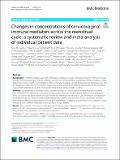Changes in concentrations of cervicovaginal immune mediators across the menstrual cycle: a systematic review and meta-analysis of individual patient data
Author(s)
Lauffenburger, Douglas
DownloadPublished version (2.777Mb)
Publisher with Creative Commons License
Publisher with Creative Commons License
Creative Commons Attribution
Terms of use
Metadata
Show full item recordAbstract
Background
Hormonal changes during the menstrual cycle play a key role in shaping immunity in the cervicovaginal tract. Cervicovaginal fluid contains cytokines, chemokines, immunoglobulins, and other immune mediators. Many studies have shown that the concentrations of these immune mediators change throughout the menstrual cycle, but the studies have often shown inconsistent results. Our understanding of immunological correlates of the menstrual cycle remains limited and could be improved by meta-analysis of the available evidence.
Methods
We performed a systematic review and meta-analysis of cervicovaginal immune mediator concentrations throughout the menstrual cycle using individual participant data. Study eligibility included strict definitions of the cycle phase (by progesterone or days since the last menstrual period) and no use of hormonal contraception or intrauterine devices. We performed random-effects meta-analyses using inverse-variance pooling to estimate concentration differences between the follicular and luteal phases. In addition, we performed a new laboratory study, measuring select immune mediators in cervicovaginal lavage samples.
Results
We screened 1570 abstracts and identified 71 eligible studies. We analyzed data from 31 studies, encompassing 39,589 concentration measurements of 77 immune mediators made on 2112 samples from 871 participants. Meta-analyses were performed on 53 immune mediators.
Antibodies, CC-type chemokines, MMPs, IL-6, IL-16, IL-1RA, G-CSF, GNLY, and ICAM1 were lower in the luteal phase than the follicular phase. Only IL-1α, HBD-2, and HBD-3 were elevated in the luteal phase. There was minimal change between the phases for CXCL8, 9, and 10, interferons, TNF, SLPI, elafin, lysozyme, lactoferrin, and interleukins 1β, 2, 10, 12, 13, and 17A. The GRADE strength of evidence was moderate to high for all immune mediators listed here.
Conclusions
Despite the variability of cervicovaginal immune mediator measurements, our meta-analyses show clear and consistent changes during the menstrual cycle. Many immune mediators were lower in the luteal phase, including chemokines, antibodies, matrix metalloproteinases, and several interleukins. Only interleukin-1α and beta-defensins were higher in the luteal phase. These cyclical differences may have consequences for immunity, susceptibility to infection, and fertility. Our study emphasizes the need to control for the effect of the menstrual cycle on immune mediators in future studies.
Date issued
2022Department
Massachusetts Institute of Technology. Department of Biological EngineeringJournal
BMC Medicine
Publisher
Springer Science and Business Media LLC
Citation
Lauffenburger, Douglas. 2022. "Changes in concentrations of cervicovaginal immune mediators across the menstrual cycle: a systematic review and meta-analysis of individual patient data." BMC Medicine, 20 (1).
Version: Final published version